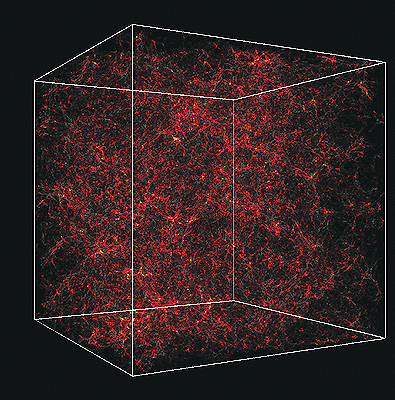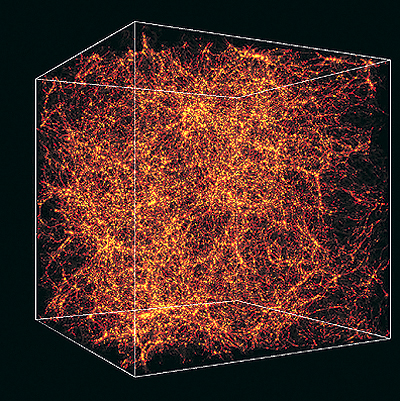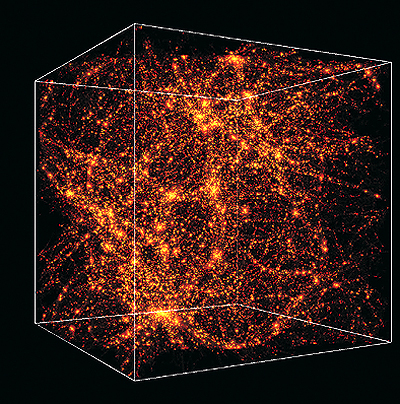Simulations show dark matter’s role in galaxy formation
By Steve KoppesNews Office
   The three images at above from a supercomputer simulation of the evolution of the universe show a cubic volume of outer space measuring approximately 280 million light years across. The images portray, from top to bottom, the universe 470 million years, 2.1 billion years and 13.4 billion years (the present) after the big bang. The bright dots correspond with high concentrations of dark matter, which are associated with sites of galaxy formation. The simulations show how dark matter herded luminous matter in the universe from its initial smooth state into the cosmic web of galaxies and galaxy clusters that populate the universe. | |
Scientists at the University have bolstered the case for a popular scenario of the big bang theory that neatly explains the arrangement of galaxies throughout the universe. Their supercomputer simulations show how dark matter—an invisible material of unknown composition—herded luminous matter in the universe from its initial smooth state into the cosmic web of galaxies and galaxy clusters that populate the universe.
In previous studies, other researchers had already verified the main features of this scenario, called the cold dark matter model. The Chicago team extended this work by comparing the results of their supercomputer simulations to the newest, most detailed astronomical observations available. They found an excellent fit, and they did so without basing their simulations on a lot of complex assumptions.
“The model we use is really, really simple,” said Andrey Kravtsov, Associate Professor in Astronomy & Astrophysics. “We want to see how well this framework can do with a minimum number of assumptions.”
A paper describing these findings appeared in the Tuesday, June 20 issue of the Astrophysical Journal. Kravtsov’s co-authors are Charlie Conroy, a former research assistant at the University, and Risa Wechsler, a Fellow at the University’s Kavli Institute for Cosmological Physics. The National Science Foundation funded the project with a grant, and the National Aeronautics and Space Administration provided additional support.
Simulations that Kravtsov’s team conducted two years ago had predicted that galaxies of different luminosity or brightness would cluster differently when the universe was younger than they do today. The team’s Astrophysical Journal paper verifies that prediction and shows that similar differences appear in the recent data.
“In the early stages of evolution of the universe, each galaxy has a high probability of having a close neighbor of similar luminosity,” Kravtsov said, much more so than galaxies today. “That was what was predicted and that’s what the observations now seem to show us.”
The data that Kravtsov’s team compared to its simulations came from the DEEP2 (Deep Extragalactic Evolutionary Probe 2) survey, and from the Sloan Digital Sky Survey.
Using the Keck 10-meter telescopes in Hawaii, DEEP2 took detailed observations of how galaxies were clustered seven billion years ago, when the universe was approximately half its current age. The Sloan Survey, meanwhile, provided additional data regarding galaxy clustering from more recent epochs in the history of the universe.
“We essentially have data on the distribution of galaxies over most of the evolution of the universe, and the data are accurate,” Kravtsov said. “Although the measurements at earlier epochs have larger errors, due to smaller data sets, their accuracy and power to constrain theoretical models is quite remarkable.”
The Chicago scientists based their supercomputer simulations on the assumption that galaxies form in the center of dark-matter halos.
According to this scheme, gravity causes the dark matter in these regions to collapse into halos. These halos provide a central location where normal matter consisting of hydrogen, helium and a small amount of heavier elements would collect in gaseous form. Once this gas had cooled and condensed, it achieved sufficient density for star formation to begin on a galactic scale.
When the Chicago team compared the distribution of galaxies in its cyber universe to the real one, “that scheme turned out to work extremely well,” Kravtsov said. “It wasn’t guaranteed that it would actually work so well in reproducing the data.”
Some fields of astrophysics are less fortunate: they have a large body of data but no way to explain it. “The data just kind of hang there. Nobody quite understands what it’s telling us or how to interpret it.”
But the Chicago simulations further support the idea that the universe behaves the way the cold dark matter scenario tells them it should, that galaxies tend to form in high-density regions of dark matter.
“We understand the distribution of these dark-matter halos, and the implication of this analysis is that we also understand how the properties of these halos are related to galaxy luminosity, how bright the galaxy is,” Kravtsov said.
Brighter galaxies also are found in more pronounced large-scale structures. “If you look at fainter galaxies, their distribution becomes more diffuse. We can still see structure, but it’s not as pronounced.”
Additional data continues to become available. For example, the Sloan Digital Sky Survey has gone beyond mapping the galaxies to include measurements of the dark matter that surrounds them. And other new, high-quality data regarding the distribution of galaxies from the very early stages in the evolution of the universe are becoming available. The first comparisons of the theory’s predictions with that data indicate good agreement over the span of about 12 billion years, Kravtsov said.
![[Chronicle]](/images/sidebar_header_oct06.gif)